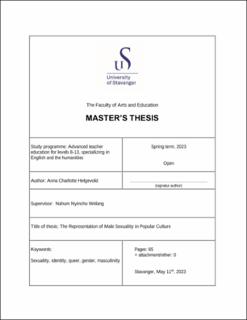| dc.description.abstract | The aim of this thesis is to explore the representation of male sexuality in popular culture and how it has changed from early twentieth century to contemporary time. In order to do this, I intend to do a comparative analysis of three novels that all depict the experience of a male protagonist who falls in love with another man. The novels are Maurice (1971) by E.M. Forster, Giovanni’s Room (1956) by James Baldwin, and Call Me by Your Name (2007) by André Aciman. Each novel is set and published in different time periods and thus work as a reflection of the time they represent.
Even though literature is my main focus, I also intend, to a small degree, to investigate the representation of male sexuality within the media landscape of Hollywood films. By examining both literature and media, it will allow a more comprehensive view of the representation of male sexuality in popular culture. Additionally, I intend to explore some of their historical changes that is underpinning contemporary attitudes toward male sexuality. The exploration of the representation of male sexuality will provide an opportunity to review how literature and media both reflect and shape social values and mainstream attitudes.
I have chosen to structure each chapter by argument. Thus, the first chapter will give the reader an overview of queer literature and its history, and an introduction of the three novels. The second chapter will investigate how sexual identity is depicted differently in each novel. The third chapter aim to explore how women are depicted in terms of the representation of male sexuality in the works. The fourth chapter will deal with media representation, with focus on the representation of male sexuality in Hollywood films. In this chapter, I intend to begin with an overview of historical changes within Hollywood film production and how these changes have influenced the portrayal of male sexuality in films. I also intend to explore the representation of male sexuality in contemporary films by examining the films Maurice (1987), Brokeback Mountain (2005) and Call Me by Your Name (2017). The final chapter will serve as a summary of my main points and arguments, then as a discussion and reflection of my findings.
Based on the findings of this thesis, there seems to have been a gradual progressiveness in the representation of male sexuality in popular culture over time. However, as this thesis will argue, the transformation is by no means complete. | |
